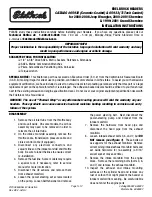
Only a rear-facing child seat provides
proper support for a baby’s head,
neck, and back.
Two types of seats may be used: a
seat designed exclusively for infants,
or a convertible seat used in the rear-
facing, reclining mode.
We strongly recommend placing a
rear-facing child seat in a back seat,
not the front. Even with advanced
airbags, which can automatically
turn the passenger’s front airbag off
(see page
), a back seat is the
safest place for an infant.
If an infant must be closely watched,
have another adult sit in a back seat
next to the baby.
If placed
facing forward, an infant could be
very seriously injured during a
frontal collision.
We recommend that an infant be
restrained in a rear-facing child seat
until the infant is at least one year
old, reaches the seat maker’s weight
or height limit, and is able to sit up
without support.
58
CONTINUED
Protecting Inf ants
Child Seat Type
Child Seat Placement
Do not put a rear-f acing child seat in
a f orward-f acing position.
Protecting Children
Driver and Passenger Saf ety
31
Placing a rear-facing child seat
in the front seat can result in
serious injury or death during a
collision.
Always place a rear-facing child
seat in the back seat, not the
front.
02/07/30 21:27:42 31S3V620 0036
















































